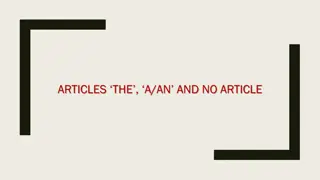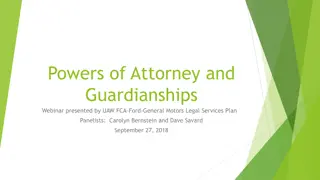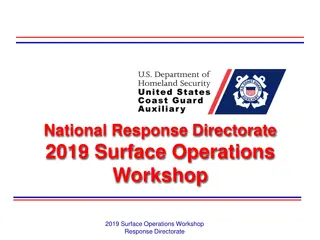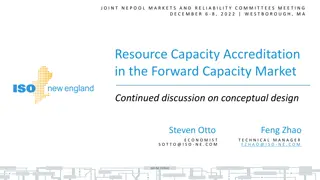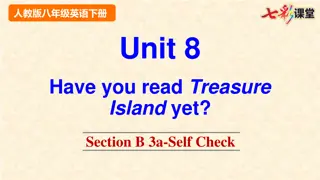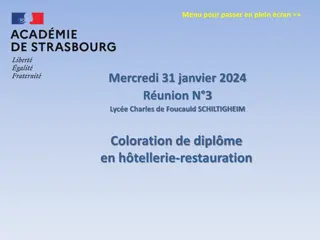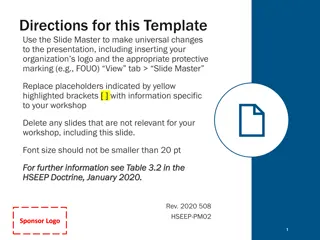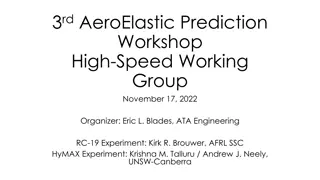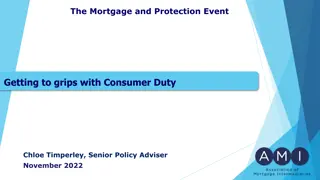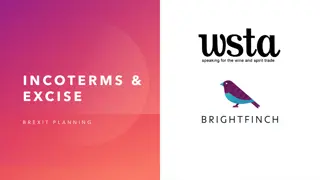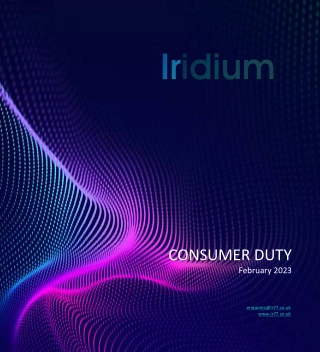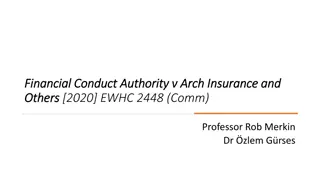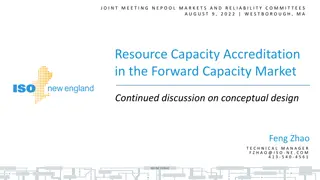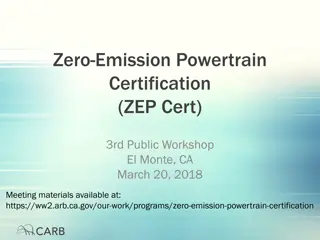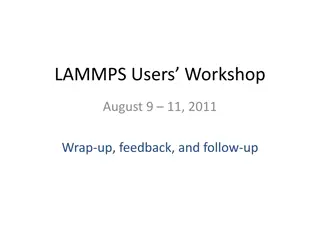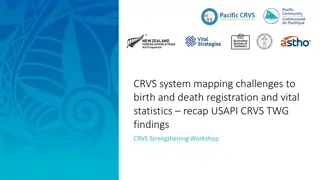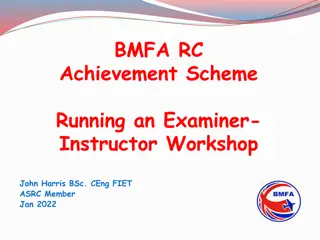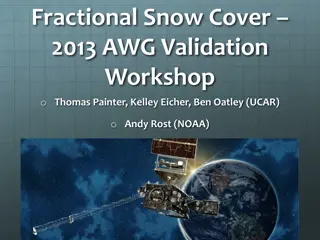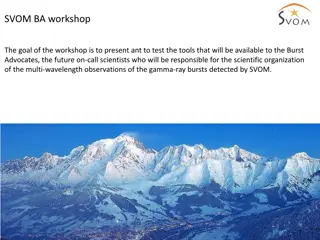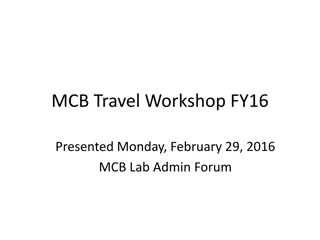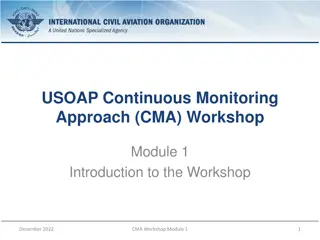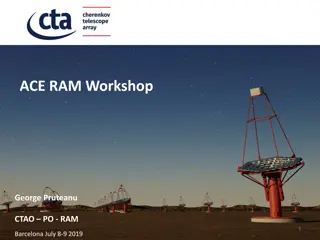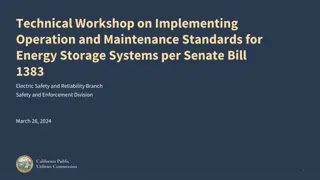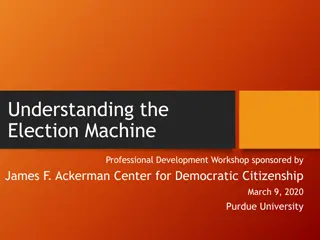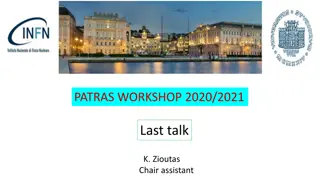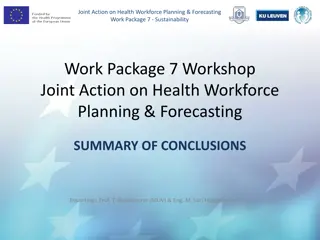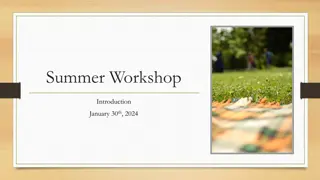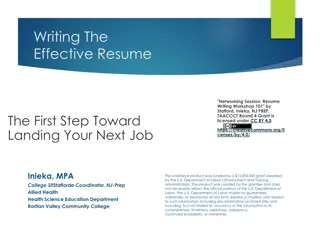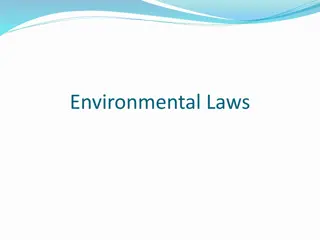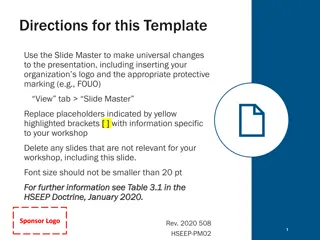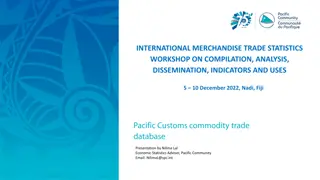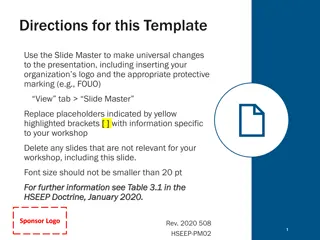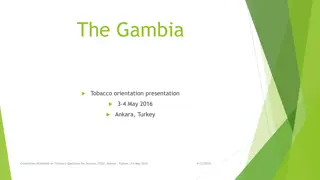Workshop Presentation on FCA Article 30 - Energinet and Svenska kraftnät
Workshop held on September 12th, 2017, by Energinet and Svenska kraftnät focusing on the involvement of market participants, brainstorming sessions, and discussions on TSO actions following rulings. The presentation covers the purpose of the workshop, today's agenda, introduction to the subject, ruling from EI and DERA, and the task of supporting financial markets by TSOs.
Uploaded on Oct 06, 2024 | 0 Views
Download Presentation

Please find below an Image/Link to download the presentation.
The content on the website is provided AS IS for your information and personal use only. It may not be sold, licensed, or shared on other websites without obtaining consent from the author. Download presentation by click this link. If you encounter any issues during the download, it is possible that the publisher has removed the file from their server.
E N D
Presentation Transcript
FCA ARTICLE 30 Workshop September 12th2017 By Energinet and Svenska kraftn t Presentation from workshop including notes 1
WHO ARE WE? Nanna Foller Larsen, Energinet Randi Kristiansen, Energinet Jenny Lagerquist, Svenska kraftn t Christina Sim n, Svenska kraftn t Who are you? 2
TODAYS AGENDA 10:40 - 11:10 Introduction to the day 11:10 - 12:00 Introduction to subject 12:00 - 13:00 Lunch 13:00 - 13.30 Brainstorm in groups 13:30 - 14:00 Qualify Ideas in groups 14:00 - 14:30 Coffee break 14:30 - 15:00 Plenum discussion and wrap up 3
PURPOSE OF TODAY Involvement of the market participants in the work Get inspiration from the market participants on the work Get opinion on preliminary work done by TSO s Follow the premise of the Ei and DERA ruling Be as creative as possible 4
11:10 - 12:00 INTRODUCTION TO SUBJECT - - - Ruling from Ei and DERA Purpose of actions from TSOs Introduction to the work of the TSOs 5
RULING FROM EI AND DERA FCA article 30 coordinated decision to not issue LTRs on DK1-SE3 and DK2-SE4 Liquidity in DK1 and DK2 was found insufficient The decision was based on an assessment by the NRAs Energinet and Svenska kraftn t has the task of supporting the financial markets according to the ruling above Proposal has to be delivered to the NRAs on November 17th The investigation is currently concentrated on investigating other measures for supporting the financial markets 6
THE TASK For whom is the TSO supporting the financial markets? The task is to support the financial markets Transmission rights between DK and SE is not to be issued The purpose is to support hedging interests Solutions that reduces liquidity premiums for hedging products can be considered The solution has to be cost efficient The cost of the solution will be compared to the gain of the market participants with hedging interests 7
SUPPORT MARKET MAKERS TSO define market maker criteria Smaller spreads Larger market maker amounts TSO contribute to the payment towards the market maker known cost DK areas already have market makers Tender would possibly mean that market makers could be on other exchanges split liquidity Doubt about the amount of bids into a tender state aid? 8
SUPPORT MARKET MAKERS Preliminary Pros and Cons Pros Pros Cons Cons Possibility of reduction of spreads Market maker already exists Possibility of trading larger volumes at the same time Unclear if supporting existing market maker increases liquidity Known cost when setup is in place Possible procurement procedure needed TSO have no additional financial obligations or costs Possibility of splitting liquidity via procurement procedure No added resources when setup is in place Risk of state aid 9
NOTES ON SUPPORT MARKET MAKER Conditions regarding the tender: Can the TSOs ask companies instead of an exchange? Depend on the cost of the tender whether TSOs can state Nasdaq should be the exchange. Conditions/terms are not present today to ensure volume and low spreads. Volume should be the result of tight spreads. Is that not just a question of costs? This is where TSOs could help with the costs. Sure that the MM solution would work for the market. How would the TSOs evaluate if the target has been reached? Not clear to TSOs, evaluations has to be done on the way. NRAs will do an evaluation every four years. Market maker will ensure that the whole curve is served (3 years, 1 week, ) Market maker is a natural way of supporting the market. It also solves the timing issue, you can trade when you want. If especially the spread is lowered the liquidity should be increased. FCA is about improving the hedging possibilities do not focus on one product. Think outside the box. Need to have production to be Market marker. History shows something else. Maybe it is a question of money. Think that there would be more companies willing to become market makers. Several companies could be interested in becoming a market maker if the market maker contract would be split into smaller volumes to enable smaller market participants to be a market maker. Idea to do this for a test period. 10
NOTES ON SUPPORT MARKET MAKER Conditions regarding the tender: Can the TSOs ask companies instead of an exchange? Depend on the cost of the tender whether TSOs can state Nasdaq should be the exchange. Conditions/terms are not present today to ensure volume and low spreads. Volume should be the result of tight spreads. Is that not just a question of costs? This is where TSOs could help with the costs. Sure that the MM solution would work for the market. How would the TSOs evaluate if the target has been reached? Not clear to TSOs, evaluations has to be done on the way. NRAs will do an evaluation every four years. Market maker will ensure that the whole curve is served (3 years, 1 week, ) Market maker is a natural way of supporting the market. It also solves the timing issue, you can trade when you want. If especially the spread is lowered the liquidity should be increased. FCA is about improving the hedging possibilities do not focus on one product. Think outside the box. Think that there would be more companies willing to become market makers. Need to have production to be Market marker. History shows something else. Maybe it is a question of money. Several companies could be interested in becoming a market maker if the market maker contract would be split into smaller volumes to enable smaller market participants to be a market maker. Idea to do this for a test period. 11
AUCTION EPADS TSO organise auctions on EPADs with a suitable (monthly/yearly/weekly/daily) frequency and suitable amount Any thought on suitable frequency? Products to auction the same as for LTTRs or should quarter be considered due to trading pattern? Auction could be done multiple places: JAO, Exchange (Nasdaq or similar) or at the TSO place would depend on social economic welfare considerations Any preferences in terms of JAO, Nasdaq or TSO to preform auction? New business area for the TSO Not currently a business area at Energinet Selling DK2 EPADs DK1 possibly buy EPADs Could buy/sell depend on time of year? E.g. Q1/Q4 have more sales interest in DK1 EPADs? 12
AUCTION EPADS Preliminary Pros and Cons Pros Pros Ensured liquidity Congestion rents somewhat hedge EPADs Clearing via exchanges removes counterparty risk Cons Cons TSOs obtain financial positions MIFID II and EMIR regulation can be imposed Doubt about the legality of using congestion rents to cover EPAD trading Unknown cost Possible need of Chinese walls to separate trading activity from other TSO activities Possible loss of confidence in TSOs neutrality Possible concentration of liquidity around auctions Auction setup has to be developed by either TSO or exchange/platform Possible split of liquidity between auction and exchanges New resources needed to handle daily operations 13
NOTES ON AUCTION EPADS (1/2) Venue for auction should have a secondary market. No problem in selling at Nasdaq after the EPAD auction. Place of auction: No problem with JAO, but a big concern with losing confidence in the TSOs when the TSO auctions financial products. EPAD rules should be kept, full firmness. No force majeure as with the LTTRs. No EU-rule for EPAD we have HAR for LTTRs. Auction a fixed volume in advance gives problem on possible underselling of the EPADs. What if you set a floor-price? Is it ok that the TSOs have an opinion on the EPAD price? Floor-price needs to be changed all the time. Need to relate to the market. Problems with the TSO setting a floor price and thereby value a fair price = opinions on price in the market that the TSOs shouldn t have an opinion on. If the TSO is transparent and base the floor price on the closing price or similar there is a risk for manipulation of the closing price. 14
NOTES ON AUCTION EPADS (2/2) Risk of split in liquidity between auction and the continuous market. Only works in the carbon market because this is already liquid. Combos would attract speculators more that single EPAD auction. The risk is bigger in the EPAD auction. Not always the case. VPP auction stimulated the trading in the EPAD market at the time of the auction. VPP gave a lot of liquidity but VPP was hourly. Auction on monthly/yearly would not increase the liquidity in the market beside the day before/after the auction. VPP created liquidity because the VPP was a different product call option. Auction is not a good idea- especially in relation to the trust in the TSO. What about a option on the underlying? Options are very flexible which is good, but they are very sophisticated not an option for the hedgers. Risk that if TSOs intervene a lot, and set max-min prices, TSOs would effect the market. Prices can be disturbed by the auctions. That is a risk and something that the TSOs need to handle. Transparency vs. not to disturb the market. 15
AUCTION EPAD COMBOS Same basic principle as single EPAD solution Difference is the auction implies a spread (simultaneous buy and sell) Secondary market could increase liquidity in single EPADs EPAD combos attractive to market participants? Sell in DK2 buy in SE4 would export issue any other ideas? DK1 could be solved by using SE3 Generally: Would EPAD solutions reduce confidence in TSO neutrality? Auction could be done outside TSO Possibly still a need for risk management trading in other products TSO has financial positions which could be seen to drive interests 16
AUCTION EPAD COMBOS Preliminary Pros and Cons Pros Pros Ensured liquidity in EPADs Congestion rents closely hedge EPAD Combos Lower profit loss risk than trading EPADs outright Cons Cons TSOs obtain financial positions MIFID II and EMIR regulation can be imposed Doubt about legality of using congestion rents to cover EPAD trading Auction setup has to be developed either at TSO or exchange Possible need for Chinese walls to separate trading activity from other TSO activities Possible loss of confidence in TSO neutrality Possible concentration of liquidity around the auction Possible split of liquidity between auction platform and exchanges New resources to handle daily operations Possible shift in liquidity from one EPAD market to another Unknown cost Not as flexible as single EPADs for market participants Cleared via exchange removes counterparty risk 17
NOTES ON AUCTION EPAD COMBOS Speculators could be interested in trading the spread. Good for the speculators not the hedgers. Could increase liquidity in the secondary market. It should be possible to only use the one leg Combo + EPAD auction By attracting both speculators and hedgers there should be more liquidity. Auction between DK and DE could help. Option TSOs should look into. What periods should be auctioned of? Depend on the interest in the market. Indications on when the TSOs have done enough? Use the indications used by the NRAs, Open interest and spreads. The measures need to be flexible to ensure that the TSOs do not worsen the market or even ruin it. 18
SERVICE PROVIDER TO TRADE EPADS Energinet would tender for a service provider to trade on behalf of Energinet Positions would still belong to Energinet Mandate to trade is setup by Energinet Trading would be spread out compared to auction based system Trading would be done in the market exactly where depends on the service provider. Same considerations on trading direction, products and volumes as EPAD auction Is it possible to create a contract where the winner does not gain a competitive advantage? 19
SERVICE PROVIDER TO TRADE EPADS Preliminary Pros and Cons Pros Pros Cons Cons Ensured liquidity in EPADs TSOs obtain financial positions Doubt about legality of using congestion rents to cover EPAD trading Congestion rent provides a hedge of profit loss Cleared via exchanges removes counterparty risk Unknown cost Chinese wall setup is avoided in some instances MIFID II and EMIR regulation can be imposed Lower resource need for daily operations Public tender for service provider Limited development in terms of implementation which makes adjustments easier Risk of giving the service provider inside information has to be managed closely 20
NOTES ON SERVICE PROVIDER TO TRADE EPADS VPP structural setup with a consultancy firm in between, with no interest in the market could be used. Challenging not to give competitive advantage. Only if the market participant get the deal itself it would approve it. TSOs are getting active in the market could be seen as the TSOs hedging there congestion rent/assets. It could be seen as more of a crime that the TSOs co not hedge their assets. TSOs should see themselves as one Nordic TSO. This would have me loose all confidence in the TSOs. TSOs have more market information which they could use. From the market point of view the trading via service provider would ensure continuous trading in the market. But still a big problem with the trust in the TSOs. 21
GROUP DISCUSSION Group 1 Group 2 Group 3 22
GROUP 1 INPUT New ideas: New ideas: Merge bidding-zones also across counties. Avoid dynamic areas. TSO ensure minimum capacity on the interconnector for the DA market (Only relevant for the interconnectors where TSOs curtail the capacity). TSOs to hedge their assets. Worst idea: Best idea: EPAD auctions on JAO. Market maker as a first step. Long-term solution to be merging of bidding-zones. FASE 1: Market maker FASE 2: Merging of bidding-zones Market maker: Market maker: Con: TSOs are depending on other and it could potentially be very expensive Setup: Week and daily products to be quoted. Trading window could be limited. (MiFID restrictions if one should be defined as Market maker.) Both volume and spread requirements needed. 23
GROUP 2 INPUT (1/2) One option could be to have fewer bidding zones. There are other developments going in a different direction, e.g. flow based calculation methods speaks for smaller bidding zones. Do we want physics to follow bidding zones or not? TSO s should have a look at who needs hedging and invest in infrastructure. In DK2 it is consumers while it is producers in DK1 in Winter season and consumers in the summer season. Energinet could draw inspiration from the Italian market, they have the PUN, and then the TSO auctions area hedges. This is more or less like TSO an EPAD auction, and everyone agreed that this is not a good solution. It might be an option to increase LTRs towards the continent, make sure that north bound capacity is available. Renewables subsidiary schemes gives a limited down side on prices, while upside will increase with new price ceilings, which increases need for north bound capacity. Liquidity decreases with LTTR, due to price exposure being moved to another bidding zone. Liquidity increases with LTTR, due to speculative positions being hedged with EPADs. Hedgers can experience better liquidity at traders with LTTRs because they have better options for hedging positions with LTRs. In order to be successful in supporting financial trading in EPADs you must support that market not LTRs. Nasdaq they are not against LTRs on to continent but in the Nordics it is not supported. Nasdaq wants to make it clear that There should be focus on a Nordic solution. NRAs say that there is a Danish bidding zone problem not a Nordic problem so a Nordic solution is not on the task set out for Energinet and Svenska kraftn t. 24
GROUP 2 INPUT (2/2) Best idea: Support market makers (perhaps combined with more LTRs towards the continent). Might be very expensive! Current market maker solution does not obligate market makers to be there when situation is difficult take September in DK2 where Kontek was out market maker was gone, market maker solution will have to obligate to be there in these situations, which is going to be very expensive. Worst idea: TSO s having financial position (auction EPAD, EPAD Combo and service provider solution).. There needs to be trust in the TSO: TSO already has financial positions with their interconnectors can be hedged with LTRs. No need to add to financial position by auctioning EPADs. EPADs could mean really big losses for TSO, this cannot be justified. TSO can use outages to their advantage in EPAD positions, there only needs to be one time where the market has doubts about the TSO s intentions when having maintenance and then the trust in the TSO is gone from the market maker perspective. The good thing about EPADs is that it supports liquidity in the existing market, which all can agree is good. 25
GROUP 3 INPUT (1/2) Market maker solution: Market maker solution: Natural market design. Easy to implement. Splitting the liquidity if in other exchange than Nasdaq no use of measure. Subsidy in favour for the tendered ones. Already today 2 market makers! Value added with a 3thrd? Key factor: Number of market participants and remember who are the natural players. Service provider: Service provider: Not a natural TSO role, task or duty. Negative external effects for the market. Worst case. Almost as worse as if the TSO would be a market maker. Sort of central banking. Unknown prerequisites for Market participants. Merge the Nordic TSOs to one Nordic TSO: Merge the Nordic TSOs to one Nordic TSO: Promotes liquidity internally TSOs Out of scope Merge SE4 and DK1: Merge SE4 and DK1: Increases liquidity in financial market due to bigger area. Exporting the problem to neighbouring countries Differences in national legislation Out of scope Does perhaps not solve the problem in DK2 since there is more consumption than production in SE4. 26
GROUP 3 INPUT (2/2) Go for LTTRs (PTR/FTR) according to FCA Go for LTTRs (PTR/FTR) according to FCA GL: Creates need for trade. Known product easy to implement. Not a true hedging product Out of scope between DK and SE Best idea: GL: Market maker option. Worst idea: Harmonized products with the same time Harmonized products with the same time windows: Simplifies trade between DK areas and rest of the Nordics. Does not solve the problem in DK areas. windows: Service provider option. Change the legislation as regards Change the legislation as regards RES: Reduce the challenges with negative prices Creates a need for hedging also for RES RES: Skip Skip system price: system price: Reduce the link to system price. Speculative traders cannot trade Sys and hopefully move their trade to EPADs Eliminates a true hedging market and the necessary link to the physics Risk of not solving the problem, since speculative traders probably only would trade in well functioning areas. 27
WRAP UP Any new ideas Qualify current ideas 28
NEXT STEPS We will take your comments under advisement potential new ideas will be investigated Legal assessment of current options are in progress Options will be evaluated on criteria of Social Economic Welfare and compliance with regulation Proposal will be submitted for Ei and DERA on November 17th 2017 November 17th 2017 Due to limited time for the proposal there will not be further workshops If comments should arise at a later point please contact us however the later the comment the more difficult it will be to consider 29
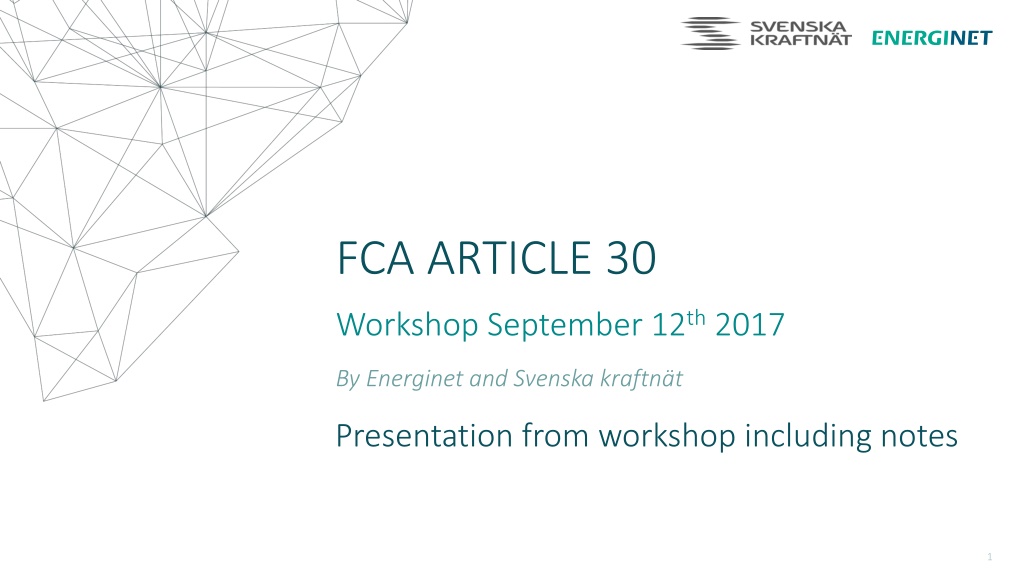

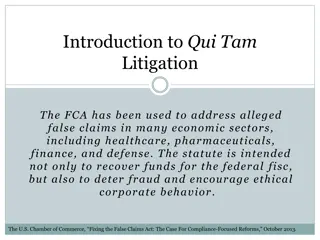
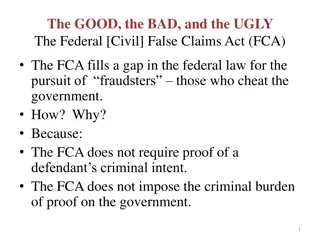
![Legal Dispute Analysis: FCA v ARCH and Others [2021] UKSC 1](/thumb/189783/legal-dispute-analysis-fca-v-arch-and-others-2021-uksc-1.jpg)
